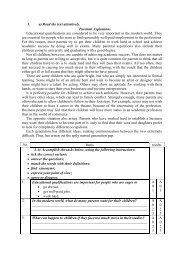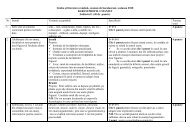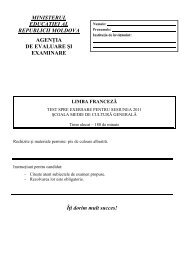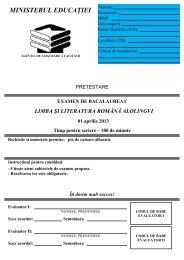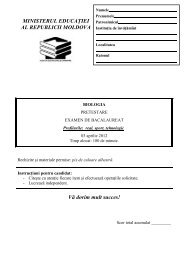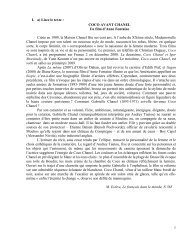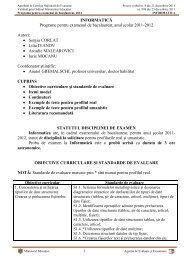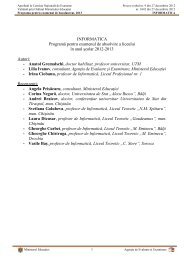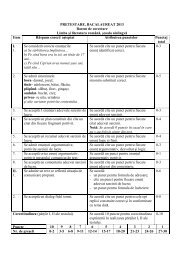I. Lisez le texte. La vie de famille Jean-Pierre a décidé de ... - AEE
I. Lisez le texte. La vie de famille Jean-Pierre a décidé de ... - AEE
I. Lisez le texte. La vie de famille Jean-Pierre a décidé de ... - AEE
You also want an ePaper? Increase the reach of your titles
YUMPU automatically turns print PDFs into web optimized ePapers that Google loves.
9. Indiquez, pour chacune <strong>de</strong>s affirmations suivantes, si l’information donnée estvraie (V) ou fausse (F). Justifiez la réponse par <strong>de</strong>s phrases du <strong>texte</strong>.1. <strong>La</strong> famil<strong>le</strong> reste un lieu où vous ne vous sentez guère protégés et que vous rêvezla quitter un jour pour toujours.________________________________________________________________________________________________________________________________________L01234L012342. Vous avez beaucoup changé, physiquement et dans votre esprit.________________________________________________________________________________________________________________________________________10. Expliquez cette phrase …Mais malgré cela … <strong>La</strong> famil<strong>le</strong> avant tout.________________________________________________________________________________________________________________________________________________________________________________________________________________________________________________________________________________________________________________________________________________________________________________________________________________________________________________________________________________________________________________________________________________________________L0357L0357
The peaceful or vio<strong>le</strong>ntnature of the remaining tencultures could be predictedfrom whether ado<strong>le</strong>scentsexual expression wassupported or punished. Inshort, these two measuresof affectional bonding: a)mother-infant/child relationshipand b) ado<strong>le</strong>scentsexual relationshipscould predict with 100%accuracy the peaceful orvio<strong>le</strong>nt nature of these 49tribal cultures distributedthroughout the world.My subsequent studieson 26 tribal cultures,whose weaning age was2.5 years or greater, foundthat 77% of these cultureswere rated low or absentin suici<strong>de</strong>. Suici<strong>de</strong> ratings were significantlydifferent between cultures withweaning age of two years or <strong>le</strong>ss versus2.5 years or greater. It appears that avulnerab<strong>le</strong> period in brain <strong>de</strong>velopmentexists at this time to explain this difference.Affectional bonding in the motherinfant/childrelationship influences laterSomatoSensory AffectationalDeprivation (SSAD)- altering thehardwiring and software of the <strong>de</strong>velopingbrainSSAD (SomatoSensory Affectional Deprivation) is theprocess of impaired or fai<strong>le</strong>d mother-infant bondingthat results from a <strong>de</strong>ficiency in the infant’s sensorystimulation via touch, body movement, smell and taste andbreastfeeding. Virtually all infant mammals are vulnerab<strong>le</strong>to the emotional-behavioural disor<strong>de</strong>rs that are inducedby this somatosensory <strong>de</strong>privation. The specific emotionalbehaviouraldisor<strong>de</strong>rs that result, vary by species and havetheir influence throughout the lifespan of the individual.The principal emotional-behavioural disor<strong>de</strong>rscharacteristic of most SSAD-reared mammals inclu<strong>de</strong>:<strong>de</strong>pression; chronic-stimulus seeking (obsessive-compulsive)behaviours, (e.g., stereotypical rocking, thumb/penis sucking,and self-mutilation; hyperactivity and hyper-reactivity);tacti<strong>le</strong> avoidance, impaired pain and p<strong>le</strong>asure perceptions;hypersensitivity to touch; impaired sexual p<strong>le</strong>asure andsexual functioning; alcohol/drug abuse, <strong>de</strong>pen<strong>de</strong>nce, andaddiction; and social alienation with anti-social behavioursthat inclu<strong>de</strong> vio<strong>le</strong>nce, suici<strong>de</strong> and homici<strong>de</strong>.SSAD induces a variety of neurobiological changes inthe <strong>de</strong>veloping brain of SSAD-reared mammals, particularlyprimates, which create the above-<strong>de</strong>scribed emotionalbehaviouraldisor<strong>de</strong>rs. These brain-behavioural disor<strong>de</strong>rsoccur primarily in the subcortical emotional-social-sexualSomatic (bodily)p<strong>le</strong>asure is theglue ofaffectionalbonding.Photo by Katrina Folkwellsexual affectional relationships where82% of cultures with weaning age of 2.5years or greater also supported youthsexual relationships and were rated lowor absent in suici<strong>de</strong>.These critical findings need to bereplicated on mo<strong>de</strong>rn human culturesthat utilise mo<strong>de</strong>rn technologies ofbrain-behavioural <strong>de</strong>velopment assessment,studies that the NIH has yet toconduct. WHO and UNICEF recommendbreastfeeding for ‘two years ofage or beyond’.Transmitting joy through breastfeedingIn America, only 6.8% of mothers arebreastfeeding at 12 months; 2.7% at 24months; and 1% at 30 months. 1part of the brain that unfolds early in <strong>de</strong>velopment — notthe neocortical rational/cognitive brain that results fromlater brain <strong>de</strong>velopment. A more comp<strong>le</strong>te and <strong>de</strong>tai<strong>le</strong>dillustration and <strong>de</strong>scription of SSAD can be found athttp://vio<strong>le</strong>nce.<strong>de</strong>/prescott/afb/paper.pdf and http://www.vio<strong>le</strong>nce.<strong>de</strong>/prescott/mp/artic<strong>le</strong>.html and on The Originsof Love and Vio<strong>le</strong>nce CDROM availab<strong>le</strong> at www.byronchild.comSomatic (bodily) p<strong>le</strong>asure is the glue of affectionalbonding. The fai<strong>le</strong>d <strong>de</strong>velopment of the normal p<strong>le</strong>asuresystems of the brain, through SSAD, induces disor<strong>de</strong>redp<strong>le</strong>asure-seeking behaviours, whether through misuse/abuse of the sensory systems or from biochemical drugs.Primary treatment of SSAD disor<strong>de</strong>rs must involve thereconstruction of the p<strong>le</strong>asure systems of the brain sothat neuro-integrative p<strong>le</strong>asure and not neuro-dissociativep<strong>le</strong>asure becomes the reality. (Gen<strong>de</strong>r inequality, sexualvio<strong>le</strong>nce, narcissism, sado-masochism, addictions andobsessive-compulsive pornography are examp<strong>le</strong>s of theconsequences of the neurodissociative brain.) The neurodissociativebrain, induced by SSAD, mediates <strong>de</strong>pression,anger/rage, and vio<strong>le</strong>nce, whereas the neuro-integrativebrain mediates joy, compassion, peace, and happiness.Integrated bodily p<strong>le</strong>asure is essential for the evolutionary<strong>de</strong>velopment of love in Homosapiens, which has beendisplaced by a disembodied Platonic/divine love that driveshuman alienation, <strong>de</strong>pression and vio<strong>le</strong>nce.James W. Prescott, Ph.D.19
III Sujet d’écriture créative 40 pointsDécrivez une tradition <strong>de</strong> notre pays. Donnez un titre suggestif à votre <strong>texte</strong>(environ 15-20 lignes).L012345678910111213141516171819202122232425262728293031323334353637383940L012345678910111213141516171819202122232425262728293031323334353637383940L01234567891011121314151617181920212223242526272829303540L01234567891011121314151617181920212223242526272829303540



